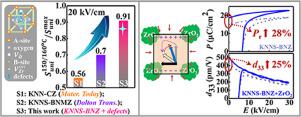Acta Materialia ( IF 9.4 ) Pub Date : 2021-09-26 , DOI: 10.1016/j.actamat.2021.117351 Xi-xi Sun 1 , Ruichen Li 1 , Chunlin Zhao 1 , Xiang Lv 1 , Jiagang Wu 1

|
Although the composition-driven multi-phase coexistence strategy has been widely used to modify the piezoelectric properties of potassium sodium niobate ((K, Na)NbO3, KNN) based ceramics, the trade-off between long-range ferroelectric ordering and chemical additives-induced disorder hinders the further improvement of piezoelectricity and makes the electric field-induced strain temperature-dependent. Herein, to resolve two issues, we proposed a new concept, that is, manipulating defect dipoles and local stress of a pre-constructed multi-phase coexistence through controlling zirconium (Zr) content. We validated the new concept by designing 0.96(K0.4Na0.6)Nb0.955Sb0.045O3-0.04(Bi0.5Na0.5)Zr(1+x)O3 ceramics. In samples with Zr deficiency (i.e., x=-0.1), we obtained high retention of 91% in normalized unipolar strain (Suni) over the temperature range of 30-160 °C, even under low electric fields of 10-20 kV/cm, superior to those of other representative KNN-based ceramics. In samples with slight Zr excess (i.e., x=0.07), we achieved an increase in direct piezoelectric coefficient (d33) and converse piezoelectric coefficient () by 12% and 25%, respectively, in comparison with that at x=0. The enhanced temperature stability stems from the released domain walls that are pinned by defect dipoles, and the increased d33 (and ) originates from the synergetic contributions of the multi-phase coexistence, increased grain size, and stabilization of the ZrO2 secondary phase. Therefore, our new concept would benefit the composition design and performance improvement of KNN-based ceramics in the future.
中文翻译:

一种简单的方法,两种显着的改进:操纵缺陷偶极子和 (K, Na)NbO3 基陶瓷的局部应力
尽管成分驱动的多相共存策略已被广泛用于改变铌酸钾钠 ((K, Na)NbO 3 , KNN) 基陶瓷的压电性能,但长程铁电有序和化学添加剂之间的权衡引起的无序阻碍了压电性的进一步提高,并使电场引起的应变与温度有关。在此,为了解决两个问题,我们提出了一个新概念,即通过控制锆 (Zr) 含量来操纵预构建多相共存的缺陷偶极子和局部应力。我们通过设计 0.96(K 0.4 Na 0.6 )Nb 0.955 Sb 0.045 O 3 -0.04(Bi0.5 Na 0.5 )Zr (1+ x ) O 3陶瓷。在 Zr 缺乏(即x =-0.1)的样品中,即使在 10-20 kV 的低电场下,我们在 30-160 °C 的温度范围内在归一化单极应变 ( S uni ) 中获得了 91% 的高保留率/cm,优于其他具有代表性的 KNN 基陶瓷。在 Zr 略微过量(即x = 0.07)的样品中,我们实现了直接压电系数 ( d 33 ) 和逆压电系数 () 与x = 0 时的情况相比,分别降低了 12% 和 25% 。增强的温度稳定性源于被缺陷偶极子固定的释放畴壁,以及增加的d 33(和) 源于多相共存、晶粒尺寸增加和 ZrO 2第二相稳定的协同作用。因此,我们的新概念将有利于未来 KNN 基陶瓷的成分设计和性能改进。



























 京公网安备 11010802027423号
京公网安备 11010802027423号